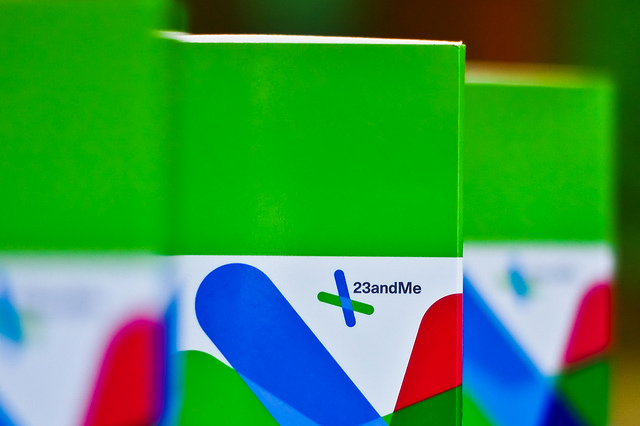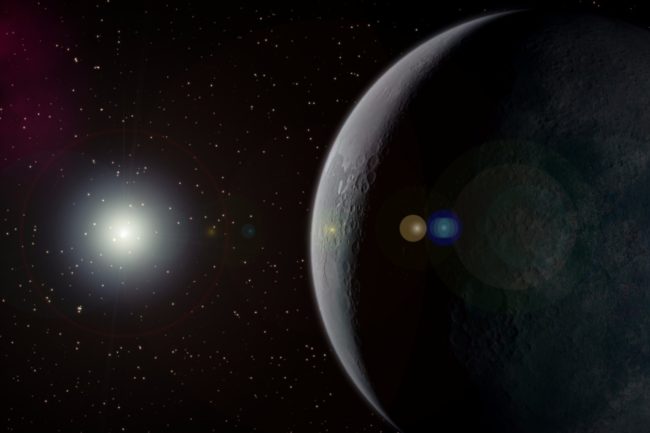Maybe that’s what it’ll look like. Maybe. | Image: Kevin Gill, CC BY 2.0
This week we’ve got news of a crowdsourced science project helping to look for Planet Nine, a new license for 23andMe to tell you about your disease risks, and more evidence describing why you can’t walk from Dover to Calais anymore—it’s the weekly roundup for Sunday, April 9, 2017!
Looking For Planet Nine
News broke this week that thanks to a crowd-sourced science initiative a number of candidates have been found for “Planet Nine,” the mathematically predicted replacement for Pluto in the ranks of non-Dwarf planets in our solar system. Back in January of last year, Konstantin Batygin and Mike Brown (aka “the Pluto Killer”) announced that they had predicted the existence of a ninth planet in our solar system, by looking at the odd motions of Kuiper Belt Objects around the Sun. Planet Nine should be there, about 20 times further away from the Sun than Neptune—which is really, really far away. You know how they say, if the sun just “went out,” it’d take eight minutes for the news to get to Earth? It’d take 4.1 hours for Neptune to get the message. It’d take 82 hours, over three days, before Planet Nine noticed. So it’s little wonder we haven’t seen it yet, even if it is supposed to be ten times Earth’s mass. Anyway the Australian National University’s Siding Spring Observatory took data from their SkyMapper telescope and put it online on a site called Zooniverse. The basic idea was that their camera had taken shots of a large part of the sky already, and multiple times, so they tinted different shots of the same sky at different times different colours, and overlaid them. Any dots sticking out had pretty clearly moved. Nearly 60,000 people helped out (myself included) and in three days they’d gone through what would’ve taken them roughly 4 years of work. Four potential Planet Nine candidates were identified (one of which it turns out is almost certainly an asteroid), and a further four million other objects have been identified by the effort, so even if they don’t find it on this pass, it’s a great method for future work. You can check out more on the story at Scientific American, and check out Zooniverse.org for more citizen science projects you can help out with!

23andMe (and My Disease Risks)
The US FDA has just this week given the home genetics testing company 23andMe the green light to test for genetic risk factors for ten diseases. This is the first time the FDA has given a private company the go-ahead to give disease risk information direct to consumers without a doctor or medical professional acting as an intermediary. The new service will operate alongside their current “Health + Ancestry Service” which, for $199, will currently tell you not only things about your genetic ancestry, but also things about (for instance) your genetic predisposition to weigh more or less than average, or your proclivity for lactose intolerance. Starting soon, it will also provide customers with details of the presence or absence of certain genes that heighten the risks of developing certain diseases, such as Celiac Disease, Late-Onset Alzheimer’s Disease, and Parkinson’s Disease (full list at the 23andMe blog). It’s important to remember that these markers don’t mean a person will get the diseases either, but only that their risks are higher—the presence of one copy of the gene LRRK2, for instance, raises the risk of getting Parkinson’s by 25%. That means that instead of 1-2% risk it’s more like 1.25-2.5%, not that their risk is 25%. On the other hand, the presence of the gene GBA raises a person’s risk of Parkinson’s 400%, making their risk more like 4-8%. This still means you’re vastly more likely than not to not get Parkinson’s—i.e. your risk of not getting Parkinson’s even with GBA is still 92-96%. That said, the new service will offer to connect you with a genetics counselor if you want one, and it appears that customers will have to check a box to request the information, too. You can read more about it at the New York Times, or over at 23andMe’s blog.

Clues About The “Original” Brexit
Once upon a time, the island that would later come to be known as Britain was connected to the continent by land. The white cliffs of Dover stretched right across what’s now the English Channel and all the way over to just south of Calais. The world was in the middle of a pretty phenomenal ice age, and the North Sea was home to a truly massive “proglacial” lake, meaning it had an even more massive ice sheet just to the north of it. We’re still not sure exactly how the land bridge failed, but new research by a team of geologists suggests that about 450,000 years ago this lake flowed over the chalk escarpment and eroded it in pretty impressive ways. Giant round holes that have been found in the bedrock of the sea floor—we’re talking several kilometers wide and a hundred metres deep, into solid bedrock(!!)—are best explained as “plunge pools,” holes eroded in the bedrock by truly massive waterfalls. This situation might’ve been fairly stable, with the ridge being about 100m high and holding back the giant lake for tens or even hundreds of thousands of years. We’re still not sure what caused the second, “megaflood” event that fully collapsed the ridge, but if these kinds of events happened with each interglacial period, it would provide a mechanism for the erosion and eventual failure of the ridge itself. You can read more about the work that led to this model over at phys.org, or read the study itself, “Two-stage opening of the Dover Strait and the origin of island Britain,” at Nature.
ICYMI
In case you missed any of it, here’s what we got up to this week!
- On Monday, I expressed my concerns about Gaston’s five dozen eggs a day diet
- On Tuesday, I covered “witchcraft” charges being levelled against a man in Toronto
- On Wednesday, Prudence talked about the Japanese practice of shisa kanko and why looking silly could save lives
- On Thursday, I rolled my eyes at the claim of GMO-free whiskey, and
- On Friday, Elle gave us an exhaustive explanation of the myraid things wrong with the animated Killing Joke movie
Go check them out!
Best of the Rest
And because there’s always more to read than I can cover, here it is, your weekly linkspam:
- Japan’s making plans to drill through the entire crust of the Earth
- The Trump administration tried and failed to unmask a Twitter “alt-account”
- Germany’s passing a law against online hate speech and fake news
- Ubuntu’s killing Unity and switching back to GNOME
- Putin tried to make sharing a picture of himself as a gay clown illegal, and the Streisand Effect happened
- Google designed a new AI that saved it from building a couple dozen data centers
- John Simm’s coming back to Doctor Who as the Master, and
- That US-Japan “giant robot fight” now has a date.
That’s all for today. Have a great week.
***
Thanks again for reading. Except for the very *very* occasional tip, we only get paid in my own (and your) enthusiasm, so please like This Week In Tomorrow on Facebook, follow us on Twitter @TWITomorrow, and tell your friends about the site!
If you like our posts and want to support our site, please share it with others, on Facebook, Twitter, Reddit — anywhere you think people might want to read what we’ve written. If there’s something you think we’ve missed or a story you’d like to see covered, drop us a line! Thanks so much for reading, and have a great week.
***
Richard Ford Burley is a human, writer, and doctoral candidate at Boston College, as well as Deputy Managing Editor at Ledger, the first academic journal devoted to Bitcoin and other cryptocurrencies. In his spare time he writes about science, skepticism, feminism, and futurism here at This Week In Tomorrow.

